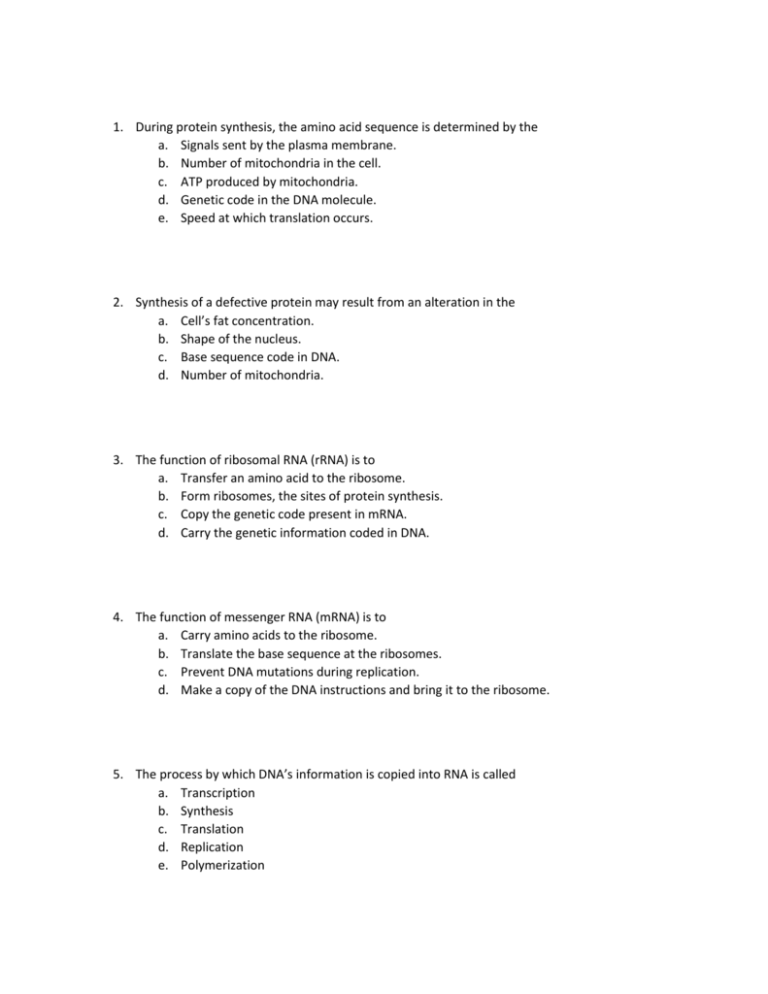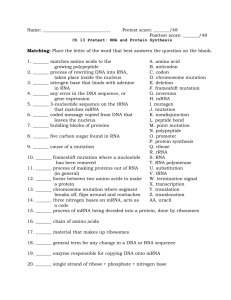During protein synthesis, the amino acid sequence is determined by
advertisement

1. During protein synthesis, the amino acid sequence is determined by the a. Signals sent by the plasma membrane. b. Number of mitochondria in the cell. c. ATP produced by mitochondria. d. Genetic code in the DNA molecule. e. Speed at which translation occurs. 2. Synthesis of a defective protein may result from an alteration in the a. Cell’s fat concentration. b. Shape of the nucleus. c. Base sequence code in DNA. d. Number of mitochondria. 3. The function of ribosomal RNA (rRNA) is to a. Transfer an amino acid to the ribosome. b. Form ribosomes, the sites of protein synthesis. c. Copy the genetic code present in mRNA. d. Carry the genetic information coded in DNA. 4. The function of messenger RNA (mRNA) is to a. Carry amino acids to the ribosome. b. Translate the base sequence at the ribosomes. c. Prevent DNA mutations during replication. d. Make a copy of the DNA instructions and bring it to the ribosome. 5. The process by which DNA’s information is copied into RNA is called a. Transcription b. Synthesis c. Translation d. Replication e. Polymerization 6. The process by which mRNA’s information is turned into proteins is called a. Transcription b. Replication c. Mutation d. Polymerization e. Translation 7. Which is the first step in translation? a. The mRNA attaches to a ribosomes. b. The amino acids are linked together c. DNA is a template for RNA synthesis d. The tRNA attaches to a codon 8. DNA transcription takes place in the cell’s a. Nucleus b. Cell membrane c. Mitochondria d. Chloroplast e. Ribosomes 9. The mRNA receives information from DNA by a. Joining with the two DNA strands and forming a triple helix b. Making an exact copy of both strands of the DNA molecule c. Joining with its complementary bases on a single DNA strand d. Accepting proteins through the nuclear membrane pores 10. Which of the following represents the codons that correspond to the segment TATCAGGAT of DNA? a. ATA-GTC-CTA b. AUA-GUC-CUA c. AUAGU-CCUA d. TCA-CUG-GUA e. ACA-CUC-GUA 11. During transcription, the genetic information for making a protein is encoded as a molecule of a. Messenger RNA b. Transfer RNA c. Ribosomal RNA d. Translation RNA 12. Like DNA, RNA contains which of the following? a. Deoxyribose b. Uracil c. Phosphate d. Double helix e. Thymine 13. The connection between hereditary traits and genes requires the deciphering of the information encoded in genes into a. Amino acids b. Nucleotides c. Complementary bases. d. Histone molecules e. Proteins 14. By what molecules are amino acids transported to the ribosome in building the polypeptide? a. rRNA b. tRNA c. DNA ligase d. DNA polymerase e. mRNA 15. The process in which an RNA polymerase molecule assembles an mRNA molecule complementary to the DNA sequence is called a. Gene amplification b. Polypeptide sequencing c. Complementary base pairing d. Translation e. Transcription 16. The many different functions and behaviors of living organisms are essentially based on the performance of their cells. The cell’s performance in turn is dependent upon the a. Production of steroids and hormones b. Production of correct membranes c. Production of many varieties of polypeptides and proteins d. Proper conformation for water in the cells e. Ability to reproduce 17. What is the name of the enzyme that initiates transcription? a. RNA polymerase b. DNA polymerase c. ATP synthase d. Transformation principle 18. The 3-nucleotide sequence of an mRNA is called the a. Codon b. Amino acid c. Template d. Transcript e. Anticodon 19. Eukaryotic mRNA molecules are occasionally interspersed with non-coding sequences that must be removed before protein synthesis. These are a. Nucleosomes b. Anticodons c. Introns d. Exons e. Chromosomes 20. If the DNA triplet code were ATG-CGT, the tRNA anticodons would be a. TGCGTA b. UAGCGU c. UACGCA d. ATGCGT e. AUGCGU 21. An RNA molecule is a. Usually double-stranded b. Always double-stranded c. A double helix d. Characterized by deoxyribose e. Usually single-stranded 22. What type of RNA binds to codons and thus positions attached amino acids in the correct order? a. tRNA b. heterogeneous RNA c. rRNA d. micro-RNA e. mRNA 23. What class of RNA binds free amino acids and carries them to ribosomes? a. all of them b. mRNA c. none of them d. tRNA e. rRNA 24. Which is not an anticodon? a. AUG b. UUC c. TAG d. CCG 25. During transcription, cytosine in DNA pairs with a. Guanine in RNA b. Uracil in RNA c. Adenine in RNA d. Thymine in RNA 26. In 1917 the biologist Thomas Hunt Morgan conducted studies in which he kept some caterpillars in the dark and placed some others under red, green, or blue lights. Exposure to red light produced butterflies with brightly colored wings. Exposure to green light resulted in darkcolored wings. Exposure to blue light or no light resulted in pale-colored wings. What was the most likely conclusion of Morgan’s research? a. The pigment in butterfly wings absorbs light from the environment. b. The phenotypic expression of wing shape depends on color pigmentation in butterflies c. The genes regulating wing color in butterflies are influenced by environmental factors d. Caterpillars exposed to red and green light are healthier than caterpillars exposed to no light or blue light. 27. Sickle-shaped red blood cells result from a mutation in the gene that codes for hemoglobin. This mutation results in sickle-cell anemia. A partial sequence of bases from a normal hemoglobin gene and a sequence that results in sickle-cell anemia are shown below. What type of mutation is depicted in this sequence? a. Substitution b. Insertion c. Deletion d. Frameshift 28. Which of the following polypeptides is coded for by the mRNA sequence 5’ AUGGUUAAACGACAAUCC 3’? a. b. c. d. Val, Lys, Phe, Gly, Ser Met, Asp, Phe, Ala, Arg Met, Val, Lys, Arg, Gln, Ser Ile, Gln, Lys, Asp, Gly, Leu, Ser 29. Which cellular process takes place in the ribosomes that are bound to the endoplasmic reticulum? a. The breakdown of waste material b. The conversion of radiant energy to glucose c. The synthesis of new proteins d. The replication of nucleic acid e. 30. A mutation is least likely to affect a cell when the mutation — a. Reverses the order of bases in a DNA strand b. Allows the total number of bases in a DNA sequence to remain the same c. Replaces a base with its complementary base d. Produces a triplet that codes for the same amino acid as the original triplet Protein Synthesis Easter Egg Review Answers: 1. D 2. C 3. B 4. D 5. A 6. E 7. A 8. A 9. C 10.B 11.A 12.C 13.E 14.B 15.E 16.C 17.A 18.A 19.C 20.E 21.E 22.A 23.D 24.C 25.A 26.C 27.A 28.C 29.C 30.D








